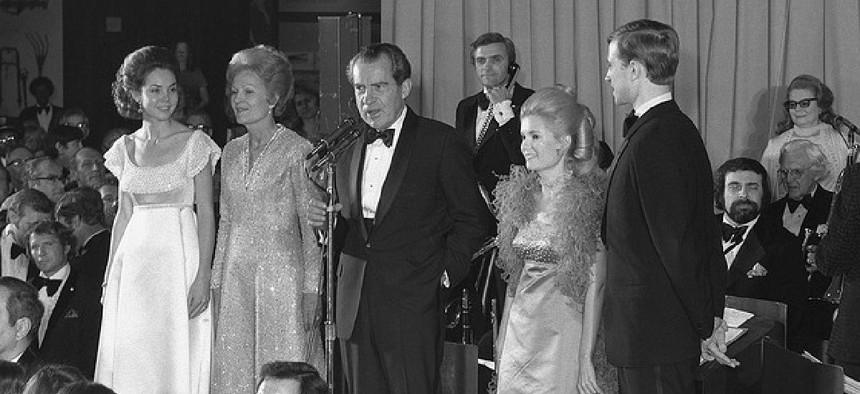
Smithsonian Institute President Nixon with his wife Patricia and daughters Julie and Trisha speaking at his Inaugural Ball in the Museum of History and Technology, now the National Museum of American History, January 20, 1973.
How Not to Start a Second Term: The Case of Richard Nixon
To celebrate his landslide victory in 1972, Nixon dropped a bombshell on his own administration.
In searching the annals of history for presidential guidance, Richard Nixon is a unique role model. With the crown of most disgraced American president safely his, Nixon’s presidential lessons are remarkably consistent: great lessons in what not to do. As President Barack Obama prepares to enter his second term, he can count on Nixon, true to part, to serve as the negative example of how to start a second term.
With 520 electoral votes and over 60 percent of the popular vote, Nixon handedly defeated George McGovern on Nov. 7, 1972. How did he follow up such a smashing victory? By dropping a nuclear bomb on his own administration. The very next day, on Nov. 8, Nixon requested the resignation of all presidential appointees including more than 1,400 Schedule C employees. Wrote the New York Times on Nov. 10, 1972: Nixon’s decision to request resignations en masse was “regarded as unusual.”
Nixon’s morale destroying model is unlikely to be replicated by Obama. Indeed, despite Obama’s well known predilection for change, his first term was a striking portrait of stability. With turnover in only two cabinet positions in his first term (Defense and Commerce), Obama’s second term is expected to see quite a bit more coming and going as well-worn, tired out political appointees look to new opportunities.
It’s the anticipation of that coming and going that has some federal managers on edge. In a survey conducted by the Government Business Council (GBC) following the Nov. 6 election, 38 percent of federal managers reported feeling transition-related anxiety around their agency. Of those surveyed, 34 percent also reported being very concerned about morale.
In the coming weeks, GBC will be releasing a new report entitled, "Presidential Transition Roadmap: Guide to the Second Term." Check GBC and Excellence in Government for more information on how you and your agency can prepare for the changes ahead as President Obama recalibrates his administration for a second term.







